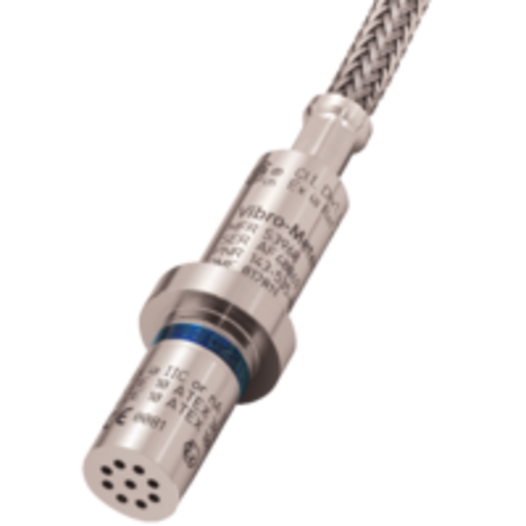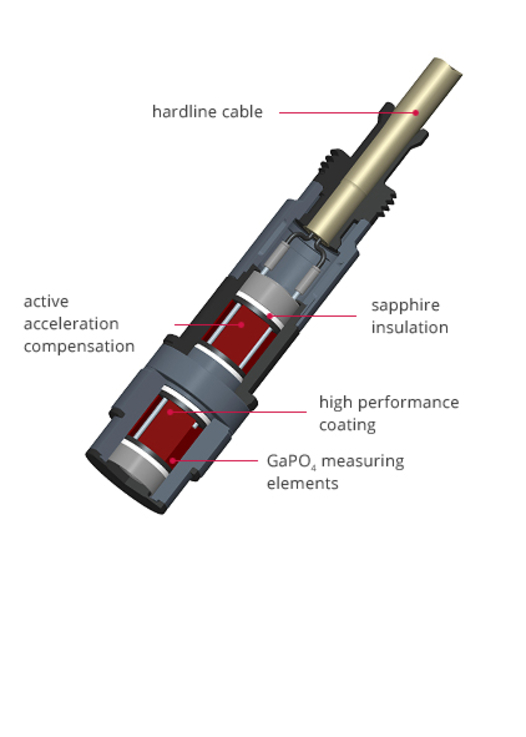
Thus, the efficiency and emissions of these turbines have a significant impact on the environment and are strictly regulated. In order to reduce nitrogen oxide emissions, lean fuel mixtures are increasingly being burned in modern gas turbines. Unfortunately, this type of lean combustion can give rise to self-excited combustion instabilities. These instabilities are a resonant phenomenon, meaning after the first occurrence it becomes a self-reinforcing process that can, at worst, lead to the complete destruction of a turbine. When combustion oscillation occurs, it always reduces turbine efficiency and significantly decreases service life. To prevent this from happening, pressure sensors are used in gas turbine combustion chambers to detect initial combustion instability. At this early stage, the turbine can be adjusted with little effort for smooth and steady combustion. High-performance piezoelectric sensors can even detect a dangerous flameout through a characteristic drop in pressure. Ideally, you could save yourself the implementation of a flame-out monitoring system.
…like our pressure transducer
CP505

This active acceleration compensated pressure transducer is ideal for acceleration sensitivity of only 0.25 mbar/g and an mbar resolution ideal for the continuous monitoring of modern gas turbines. This sensor provides excellent signals even in the hottest environments of up to 700°C. Due to its compact design, it can also be installed under challenging space limitations.
Sensor Technology
For use in gas turbines, sensors must be designed to be extremely temperature resistant and no "normal" metal alloys or plastics may be used. Consequently, Piezocryst exclusively uses refractory metal alloys, precious metals, sapphire elements and sensing elements made from single crystalline gallium phosphate (GaPO4). Even the cables are exposed to extreme thermal stress, and cooling air temperatures can exceed 500°C, excluding the use of conventional plastic insulated cables. Piezocryst uses what is known as a hardline cable; a metal cable made of extreme temperature resistant nickel-based alloy in which the conductors are embedded in compacted ceramic powder. By implementing these measures, the sensors (including the cable) can be used at a maximum operating temperatures of up to 700°C.
The insulation resistance of all components plays a critical role for use at temperatures above 400°C, especially for sensing elements. In addition to insulation elements made of sapphire, sensing elements made from GaPO4are used. This has substantial advantages compared to other piezoelectric materials because at elevated temperatures, the internal resistance is considerably higher. Therefore, the charges created at high temperatures are transported safely to the charge amplifier, a loss of signal due to insufficient insulation is avoided and only pure measurement signals are reproduced. The user can then accurately and reliably measure at lower frequencies.
Transverse GaPO4 sensing elements are used in order to achieve an excellent signal-to-noise ratio. A particular challenge is the application of fatigue endurable electrodes to the thermally anisotropic crystal material, covering the crystal two dimensionally. Piezocryst has developed various high-endurance, high temperature resistant coatings, ranging from precious metals to conducting ceramics just for this purpose, and for which Piezocryst was awarded the research prize for Nano science in the State of Styria (Steiermark), Austria.
In order to accurately measure the impact of acceleration on a turbine, these sensors were designed to be particularly acceleration resistant. Due to their extremely rigid structure, the sensors show almost no acceleration response in radical direction. By reducing relevant mass, low acceleration sensitivity was also achieved in the axial direction. For challenging measurement tasks this can be further reduced through active acceleration compensation. Here, an acceleration sensor is installed inside the pressure sensor housing, and is designed to precisely compensate for the false acceleration signal. In this case, the sensor provides the "pure" pressure signal.
